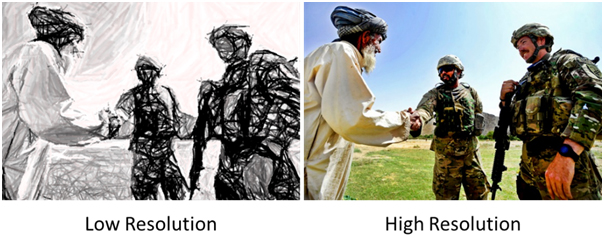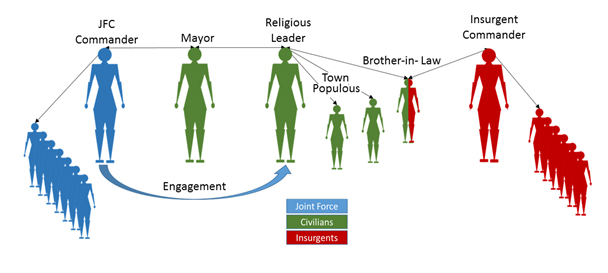Civil Information: CA is Missing the Moment
Stephen Goto
“The operational environment in which this persistent conflict will be waged will be complex, multidimensional, and increasingly fought “among the people.” Previously, we sought to separate people from the battlefield so that we could engage and destroy enemies and seize terrain. While we recognize our enduring requirement to fight and win, we also recognize that people are frequently part of the terrain and their support is a principal determinant of success in future conflicts” (Army Field Manual FM 3-0 Operations)
Introduction
“Understand the operational environment” is the first special operations (SO) imperative. For Special Operations (SO) personnel teamed with indigenous forces, efforts to understand and operate in the environment often resemble a complex puzzle with missing pieces. Civil information management, is a process for helping the commander understand the most elusive missing piece - the civil component of the operational environment. One must ask why Civil Affairs (CA) specialists, the purported experts of the civilian domain are so ill-trained and equipped to reconnoiter the civil space? This paper argues CA is missing the moment. The opportunity to produce critical information necessary to prevent, deter, and mitigate crisis and conflict, as well as prosecute and win conflicts increasingly occurring amongst the people.[i] CA forces must master the civil information management (CIM) process now to enable the joint warfighter to understand the operational environment.
These are six recommendations to make joint CIM a reality:
- Use available systems now to train, learn, and refine CIM
- Focus on analysis to help the warfighter
- Market CIM advantages to the warfighter in easy to understand terms
- Use one standard for report data
- Break rice-bowls in favor of collaborative solutions
- Seize opportunities
Use Available Systems to Train, Learn, and Refine CIM
“CIM is accomplished by the actions of CA professionals applying a disciplined approach toward managing civil information; it is not accomplished by hardware.” (Army Techniques Publication ATP 3-57-50 Civil Affairs Civil Information Management)
An informal poll of Army Reserve fulltime NCOs shows approximately half of the respondents never conduct CIM training. This is a sobering statistic since the Army Reserve is home to over 80 percent of CA forces in the Department of Defense. Historically, a long-term engagement will require multiple rotations of Army Reserve Civil Affairs forces to support stability operations and in foreign nations. The reason CIM has become a low priority effort in Army Reserve units is likely two-fold: mandatory requirements consume training-time (safety, consideration of others etc.) and a prevailing desire to “wait for the CIM hardware to get here.”
Despite over 10 years of effort, the CA community is nowhere close to a joint CIM program of record. In the end, U.S. national interests, and not CA suffer. CIM is a traditional CA activity used by CA specialists long before the introduction of computer databases. “Humans are more important than hardware” is the first SOF truth. CA personnel must be familiar with reporting formats and methods of analysis to be prepared for the next contingency. Train with spreadsheets and 3 X 5 cards if necessary to master the process then adapt to the automated system when it arrives.
Focus on Analysis to Help the Warfighter
“Identity is defined as the set of characteristics by which a person is recognizable or known. Humans define their identity in many ways, including religion, ethnicity, race, language, gender, tribe, class, occupation, geography, and nationality… However, more contact between cultures is just as likely to result in negative consequences as positive.”[ii]
Joint commanders are in constant search for certainty in an uncertain world, and in irregular warfare (IW) traditional military intelligence often falls short of Geographic Combatant Commanders (GCC) information needs. Reconnoitering the civil space enables planners and intelligence analysts to close the information gap between certainty and uncertainty.
“… we must ask why, out of the hundreds of intel analysts working in brigade-level and regional command-level headquarters, only a miniscule fraction study governance, development, and local populations – all topics that must be understood in order to prevail. “Why the Intel Fusion Center can’t give me data about the population is beyond me,” remarked the operations officer of one U.S. task force, echoing a common complaint: “I don’t want to say we’re clueless, but we are. We’re no more than fingernail deep in our understanding of the environment.”[iii]
In IW, tactical operators, operational and joint planners need answers to unique questions: which civilians are really in charge; what do people need; how much is enough; and who will help us on the ground? Answers to these and similar questions are critical for decision makers. CA teams well trained in CIM should have answers to many of these questions. Combined with intelligence, CIM can give planners crucial information for counterinsurgency, security and stability operations.

Market CIM to the Warfighter in Easy to Understand Terms
CA must market CIM to the warfighter as a critical capability. The primary CIM customers are joint planners. CA provides planners with clearer pictures of the battle space. Imagine a single piece of information as a pixel in a photo, the more information the more pixels. More pixels equal higher resolution. CIM benefits the joint warfighter by bringing higher resolution to the common operational picture.
The intelligence community already understands value of CIM. It’s the missing piece to the puzzle, connecting-the-dots between people in the operational environment. For example: understanding who local leaders are, how they relate to others, attitudes, needs, wants, strengths, weaknesses and limitations are critical tools in security and stability. In accordance with conventional wisdom, the joint force commander might choose to engage with the town mayor in order to influence public attitudes toward the local insurgency. Former director of the Defense Intelligence Agency, Michael Flynn says, “The problem is that these analysts – the core of them bright, enthusiastic, and hungry – are starved for information from the field, so starved, in fact, that many say their jobs feel more like fortune telling than serious detective work.”[iv] Intelligence analysts know when they fuse CIM with information from other sources, they might discover nuances as one local religious leader influences more of the people than the mayor through tribal or family blood-relationships with the insurgents. In numerous circumstances, fusing CIM with intelligence may reveal engaging with a religious leader holds more value than a town mayor.
Break Rice-Bowls in Favor of Collaborative Solutions
“rice bowl n. in the military, a jealously protected program, project, department, or budget; a fiefdom. Etymological Note: Perhaps related to the Chinese concept of the rice bowl as a metaphor for the basic elements required to live, as seen, for example, in the iron rice bowl, employment that is guaranteed for life.”[v]

The joint CA community is mired in rice-bowl parochialism. While CA forces in the Army Reserve (USAR), SO, Navy and Marine Corps (USMC) fought for different CIM hardware and software systems, jealousies and sequestration budget cuts triggered a “clash of rice-bowls” with techno-factions battling for supremacy and money. As a result, Army CA forces, structurally designed for CIM still do not have a common CIM system. Army Field Manual 3-57 Civil Affairs Operations added Civil Information as one of five CA core tasks, but over five years later neither the Army nor the USMC CA forces easily share civil information with each other.
This is a brief history: Beginning in 2004, Civil Affairs forces in SO, the USAR, the Navy, and the USMC each pursued separate CIM technologies. Each faction received un-programmed funds from their service to develop a system of choice. Over several years, none of the factions could coalesce on a single standard for reporting or storing data; therefore, none of the systems could share information. Meanwhile, the Navy disbanded the entire maritime CA force and the Army cut 80% of the active conventional force. SO continued to develop the SO-peculiar CIM data processing system (CIM-DPS), leaving the USAR and the USMC to fight amongst themselves.
By 2015 U.S. Special Operations Command (USSOCOM) validated an initial capabilities document (ICD) developed by the Army CA proponent for a Joint CIM system (JCIMS) to compete for funds as a joint program. The key feature of JCIMS is “platform agnosticism.” JCIMS is a data repository on the world-wide web accessible to any web enabled device, computer, tablet, or smartphone. The intent: any hardware with internet access can share information through JCIMS regardless of device.
The problem is money. A joint system requires two or more services contribute funds to a joint program. Army and the USMC have the most to gain because both services have CA forces. USSOCOM suspended CIM-DPS development and reprogrammed funds to finance JCIMS development, but the USMC is satisfied with their MARCIM system and have little desire to fund JCIMS. The Army is unhappy with MARCIM security protocols on the worldwide web. Meanwhile the USAR has access to special operations CIM-DPS but rarely trains with it.
Use One Standard for Report Data
In a race for supremacy CA forces have fielded unique, incompatible systems to capture data. Standard report formats allow multi-service CA forces to share information seamlessly, but the USAR, SO and USMC have failed to develop a joint report format. In a 2011 joint experiment, USSOCOM published a Joint CIM user’s manual and Joint CIM handbook to standardize formats, but the effort has largely been ignored by the joint CA community. The rice-bowl mantra “wasn’t invented here” appears to prevail. The outcome: valuable information from Iraq and Afghanistan is lost, and what little survives remains un-shareable. Recommended solution: factions agree on a single report standard then use it.
Seize Opportunities
At some point in the near future US forces will respond to humanitarian disasters; provide nation assistance or other stability operations to defend national interests. CA forces should be on the ground training partner and indigenous forces in CIM today. Low-tech methods such as spreadsheets and index cards work well in underdeveloped operational environments. In some operational contexts CA teams should be on the ground conducting CIM now, gathering valuable information to allow us to ‘prepare the environment’ for what comes next. Having a JCIMS ‘gadget of record,’ a database to support collection, information management and analysis simplifies the process, but are not keys to success. America’s national interests depend on finding the ways and means to support the warfighter now.
Conclusion
Deliver on the promise of CIM. Managing civil information is not a panacea for the warfighter, but it is a major step toward understanding the operational environment. Civil Affairs forces must train now using existing systems to master CIM. Use open systems on the worldwide-web such as the All Partners Access Network - APAN and MARCIM until a permanent solution arrives. Market CIM to the warfighter in simple, easy to understand terms to meet their needs. Break rice bowls wherever possible by collectively choosing hardware, software, and report formats as a community, then move forward. CA must be prepared to support the warfighter with trained experienced operators capable of conducting CIM using a common method to provide vital information and analysis. Stop missing the moment and lean forward by integrating a joint CIM process now across the services. CA forces must master the civil information management (CIM) process before the joint warfighter will understand the operational environment.
End Notes
[i] Sir Rupert Smith, The Utility of Force: The Art of War in the Modern World, 2005
[ii] Joint Operations Estimate 2035
[iii] Major General Michael T. Flynn, USA; Captain Matt Pottinger; USMC Paul D. Batchelor, DIA: Fixing Intel: A Blueprint for Making Intelligence Relevant in Afghanistan, January 2010, p. 9
[iv] Ibid, p. 9
[v] Source: Double-Tongued Dictionary, http://www.waywordradio.org/rice_bowl/

